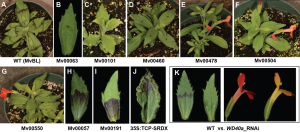The emergence of qualitatively distinct new structures or patterns (e.g., turtle shells, beetle horns, butterfly color patterns, plant flowers) is one of the most fascinating aspects of organismal evolution. How such novel, complex traits have originated and evolved remains one of the most important yet challenging problems of evolutionary biology. It is widely assumed that novel structures or patterns arise by co-option or rewiring of pre-existing developmental programs. Numerous empirical studies in the past two decades have provided correlational evidence supporting this premise. However, we still know virtually nothing about the specific genetic changes that trigger such co-option or developmental rewiring, how the genetic changes translate to novel structures or patterns (i.e., the developmental pre-settings required to produce the novel phenotype), and how the novel phenotypes rise in frequency in natural habitats (i.e., the evolutionary process). The major obstacles for the advancement of this field are twofold: (i) Morphological novelties are often investigated long after their emergence, making it difficult to elucidate the causal factors that drove the initial evolutionary transitions; (ii) Most organisms with novel phenotypes are not particularly amenable to rigorous experimental investigations. To overcome these obstacles we need systems where the novel trait has evolved recently and the organism is amenable to genetic and developmental manipulations as well as evolutionary analyses or/and ecological interrogations. This project employs exactly such a system in the wildflower genus Mimulus (monkeyflowers) and applies it to answer those fundamental questions about the origin and evolution of morphological novelty.
| Figure 1. EMS mutants and transgenic lines. (A) Wild-type. (B-G) EMS mutants with reduced anthocyanin pigmentation. (H-I) EMS mutants with anthocyanins expanded to the proximal portion of the leaf. The eight EMS mutants shown here are all non-allelic, representing eight complementation groups (i.e., genes). (J) Anthocyanins expand to the distal portion of the leaf of a transgenic line that over-expresses a TCP protein fused with a chimeric repressor motif (SRDX). (K) A WD40a RNAi line with reduced anthocyanin pigmentation in both the leaf and the flower (wild-type is on the left, RNAi phenotype is on the right). |
A qualitatively distinct pigmentation pattern – a lateral purple stripe (due to anthocyanin pigments) across the green leaf – has risen to high frequency in one natural population of M. verbenaceus (Crimson monkeyflower). To exploit this rare opportunity of a recently evolved novel morphological trait, we have developed sophisticated genomic and genetic resources and functional tools for M. verbenaceus, including an efficient stable transformation protocol and a large number of chemically induced mutants (Figure 1), to enable rigorous genetic and developmental analyses. The overall objective of this project is to identify the genetic origin, characterize the developmental pre-settings, and elucidate the evolutionary process underpinning the evolution of this novel phenotype. Our data to date suggest that cis-regulatory change in a single anthocyanin-activating gene triggers the emergence of the novel pigment pattern, but the formation of this distinct pigmentation pattern requires an elaborate developmental pre-setting involving interactions among multiple activators and repressors, which will be elucidated by analyzing the many EMS mutants with altered anthocyanin stripe patterns (Figure 1).
This project is supported by an NIH grant (R01GM131055)
